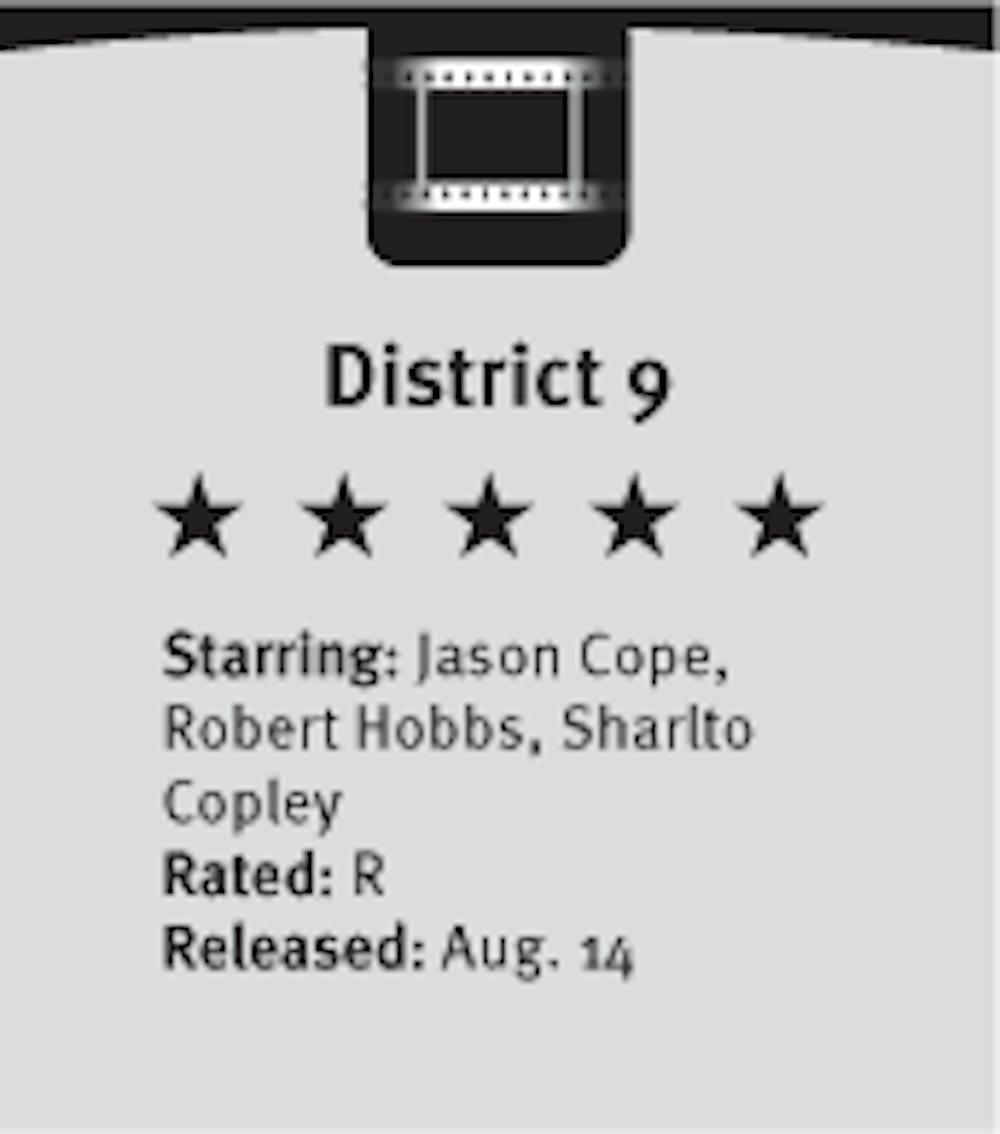District 9 is out of this world

Aliens. Guns. Exploding heads. All can be found in District 9, and all are among the many reasons that you should spend your last day of Orientation Week at this flick.Born from the ashes of director Neill Blomkamp and producer Peter Jackson's aborted Halo movie, District 9 is a fictional documentary of peculiarly unique proportions. In 1990, 20 years prior to the events in the film, a large alien ship drifted over the city of Johannesburg, South Africa. However, none of the expected invasion, exploration or Signs-inspired raiding occurred. Instead, the ship simply ... parked. Not knowing who was on board or what the ship's plans were, humans cut their way into the behemoth and discovered it contained thousands of severely ill and malnourished alien workers. With no other option than to help them, District 9, a grimy Soweto-inspired slum, was set up outside the city to house the refugee alien population.
Flash forward to the year 2010: The residents of Johannesburg have grown increasingly irritated with the resident alien population, resulting in extreme prejudice between the human and alien races. Private military corporation Multi-National United (MNU) is called in to forcibly relocate the million-plus alien population to a larger camp that is further from the city, the aptly-named District 10. The man in charge of this operation is the mild-mannered and easygoing Wikus van der Merwe (Hellweek's Sharlto Copley), who kept a chummy visage until coming across a mysterious alien canister while searching one of the district's houses.
The basic premise of District 9 is nothing new to the sci-fi genre - a lone man finding himself at the center of a much larger conflict - but Blomkamp and Jackson have taken all the genre conventions one would expect and completely ground them down, creating a film that is as fresh as it is engaging. Just when the audience feels themselves slipping into that familiar genre groove, sure of how the scene is going to end, District 9 throws them a filthy change-up.
The intensity and pace of the film wouldn't be possible without great cinematography, and District 9 delivers in spades. Utilizing archival newsreel footage and live "on-the-scene" helicopter news shots, Blomkamp has created the most succinct and successful fictional documentary since This is Spinal Tap. Nearly half the film will have you feeling like you're watching a PBS special. The sense of realism and accessibility the film engenders is unparalleled by any film out right now. Hundreds of unique and inventive camera angles are used, such as security feeds from around District 9 and Johannesburg, camera shots down the barrel of a soldier's gun as they are firing or even from the underside of a car as it crashes.
The special effects are seamlessly integrated into the film and never detract from the experience. The actors and backdrops interact remarkably well with their digital counterparts in a way that's only rarely, and exceptionally, noticeable.
There is undoubtedly an underlying theme or message of some kind in District 9 - the South African setting was chosen for a reason, after all - but it is largely overshadowed by the adrenaline-pumping action sequences that dominate the second half of the film. Some poor guy gets pile-driven through a house with a pig, for crying out loud.
But this isn't a loud and dumb Steven Seagal explosion-fest; Blomkamp and Jackson have created a movie that is as smart and thought-provoking as it is excruciatingly violent. Humans and non-humans alike are going to eat it right up, just like cat food. (See the movie. You'll get the reference.)
To view the trailer and more, visit www.d-9.com.
More from The Rice Thresher

Over 1,000 students petition against new meal plan
When Konstantin Savvon opened the Housing and Dining email announcing the new unlimited meal plan, he was instantly concerned about the impact on off-campus students like himself.

Rice football wins season opener under new coach
For the first time since 2018, Rice football opened its season with a victory. Scott Abell was soaked with yellow Powerade following a 14-12 win on the road Saturday against the University of Louisiana at Lafayette, which won 10 games and made it to the Sun Belt Conference championship last season.

Acting like an athlete: Rice basketball alum takes on Broadway
Underneath Chadd Alexander’s Broadway costume, there’s ankle tape and wrist braces — same protective gear he wore as a walk-on basketball player at Rice, though now he’s performing eight shows a week in the ensemble of “Harry Potter and the Cursed Child” instead of running conditioning drills in Tudor Fieldhouse.

Please note All comments are eligible for publication by The Rice Thresher.